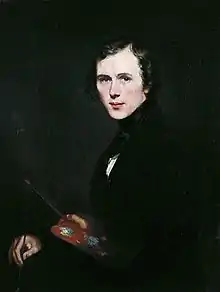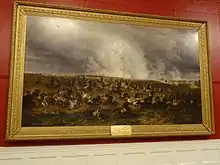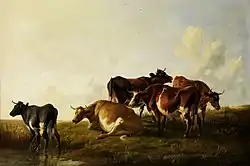


Thomas Sidney Cooper CVO RA (26 September 1803 – 7 February 1902) was an English landscape painter noted for his images of cattle and farm animals.[1]
Biography
Thomas Sidney Cooper was born in St Peter's Street in Canterbury, Kent,[2] and as a small child he began to show strong artistic inclinations, but the circumstances of his family did not allow him to receive any systematic training. By the time he was twelve years old, he was working in the shop of a coach painter. Later he obtained a job as a scene painter; and he alternated between these two occupations for about eight years. He still felt a desire to become an artist, and all his spare moments were spent drawing and painting from nature. At the age of twenty he went to London, drew for a while in the British Museum, and was admitted as a student of the Royal Academy.[3]
He then returned to Canterbury, where he was able to earn a living as a drawing-master and by the sale of sketches and drawings. In 1827 he settled in Brussels making a living through painting portraits and also becoming a drawing master. Here he met and married Charlotte Pearson. He also met Eugène Joseph Verboeckhoven who was to have a great influence on his painting. The Belgian Revolution of 1830 saw Cooper and Charlotte returning to London. He showed his first picture at the Royal Academy in 1833, beginning a long and prolific career as an exhibitor at the Royal Academy and British Institution among others.[4] His 'Intercepted Raid, Ettrick Shepherd', exhibited at the Royal Academy in 1842, an oil on canvas, sold at Sotheby’s for £37,500 making it, at that time, the most valuable work to be sold at auction.[5]
When the competition was announced for the decoration for the new Houses of Parliament, to be held at Westminster Hall in 1847, Cooper submitted The Defeat of Kellermann's Cuirassiers and Carabiniers by Somerset's Cavalry Brigade at Waterloo, June 18, 1815, without success.[6] In order to complete the picture, the artist used Siborne's model of the battlefield then on exhibition in London, while a friend in Brussels sent him breastplates worn by the various cavalry regiments, and a trooper of the Life Guards acted as a model.
One of the finest landscape painters of his day, he is mainly associated with pictures of cattle or sheep,[4] a fact that earned him the epithet "Cow Cooper".[7] Cooper collaborated between 1847 and 1870 with Frederick Richard Lee R.A. on several paintings, Lee undertaking the landscapes, and Cooper adding animals to complete the scene.[8] He was elected an Associate of the Royal Academy (ARA) in 1845 and Royal Academician (RA) on 22 June 1867.[9]
He was a great philanthropist in Canterbury, and used some of his wealth to distribute bread and coal to the poor at Christmas. (The Alms Houses in Chantry Lane Canterbury are sometimes wrongly attributed to him as they were donated by Thomas Sankey Cooper and his brother Henry.)[10]
Most notably in 1882 he developed his private art lessons into a full-fledged art school in Canterbury, located at his home and studio in St Peter's Street. In 1868, he paid to have the Sidney Cooper Gallery adapted specifically as an Art School. This was partly as a memorial to his mother Sarah (1776-1865) but also to meet the needs of poorer inhabitants who wished to study art, providing the teaching that was missing during Cooper’s early years.[11] Amongst Cooper's more well-known students was Mary Tourtel, creator and illustrator of the Rupert Bear books for children.
He left both the Gallery and house in Trust to the Canterbury City Council of the day with the condition that it be used for artistic and educational purposes. The Gallery has most recently been used by the University for the Creative Arts and Canterbury Christ Church University as a working studio and exhibition space. The Gallery has been empty since 2020 and is in some need of repair.
Cooper wrote his reminiscences, under the title of My Life, in 1890. Among many fascinating anecdotes, he recalls his meetings with JMW Turner and his commission by Queen Victoria to paint a prize bull. Thomas and Charlotte had four children; his son, Thomas George Cooper, also became an artist.
The oldest member of the Royal Academy of Arts at the time of the accession of King Edward VII in 1901, Cooper was received by the King in July 1901,[12] and appointed a Commander of the Royal Victorian Order (CVO).[13] He was so prolific a painter that the studio sale conducted by Christies in 1902 after his death lasted a full three days. Thomas Sidney Cooper is buried in the graveyard of St Martin's Church, Canterbury.
The largest public collection of Cooper paintings is owned by Canterbury City Council and housed at the Beaney House of Art & Knowledge in Canterbury. Examples are also held by the Tate Gallery, London, and the Victoria and Albert Museum, London, and other public collections, mainly in Britain.
Selected paintings
- Milking Time (1834)[14]
- A Summer's Noon (1836)
- A Drover's Halt on the Fells (1838)
- A Group in the Meadows (1845)
- Waterloo, the defeat of Kellerman's Cuirassiers (1847)
- The Shepherd's Sabbath (1866)
- Milking Time in the Meadows (1869)[15]
- The Monarch of the Meadows (1873)
- Separated but not Divorced (1874)
- Isaac's Substitute (1880)
- Pushing off for Tilbury Fort (1884)
- Cattle and Sheep in a Landscape (1888)
- On a Farm in East Kent (1889)
- Return to the Farm, Milking Time (1897)[4]
See also
Notes
- ↑ Martí, José (1982). On Art and Literature: Critical Writings by José Martí. NYU Press. p. 79. ISBN 978-0-85345-590-5. Retrieved 29 May 2020.
- ↑ "cooper-ts - Canterbury History". www.canterbury-archaeology.org.uk. Archived from the original on 30 November 2020. Retrieved 13 March 2019.
- ↑ Chisholm 1911, pp. 81–82.
- 1 2 3 Chisholm 1911, p. 82.
- ↑ http://www.freemanart.ca/cooper.htm
- ↑ "The Battle of Waterloo, 16–19 June 1815, the Defeat of Kellerman's Cuirassiers". Art UK. Retrieved 3 March 2014.
- ↑ https://www.bada.org/object/landscape-animal-oil-painting-cattle-sheep-river-thomas-sidney-cooper
- ↑ Westwood (2011) Vol. 2 Catalogue pp1-20
- ↑ "Art and artists - Royal Academy of Arts". www.royalacademy.org.uk. Retrieved 13 March 2019.
- ↑ "cooperalms - Canterbury History". www.canterbury-archaeology.org.uk. Archived from the original on 19 July 2020. Retrieved 13 March 2019.
- ↑ https://www.canterbury-archaeology.org.uk/cooper-gallery
- ↑ "Court Circular". The Times. No. 36521. London. 31 July 1901. p. 9.
- ↑ "No. 27346". The London Gazette. 16 August 1901. p. 5409.
- ↑ "Milking Time - Study of a Farm-Yard near Canterbury". Tate. Retrieved 13 March 2019.
- ↑ "Milking Time in the Meadows, 1869". Royal Academy of Arts. Retrieved 30 June 2023.
References
- Sartin, Stephen (1976). Thomas Sidney Cooper, C.V.O., R.A., 1803-1902. Leigh-on-Sea: F. Lewis.
- Westwood, Kenneth J. (2011) Thomas Sidney Cooper C.V.O, R.A. His Life and Work. 2 vols. Barrington, David Leathers Publishing.
Attribution:
- This article incorporates text from a publication now in the public domain: Chisholm, Hugh, ed. (1911). "Cooper, Thomas Sidney". Encyclopædia Britannica. Vol. 7 (11th ed.). Cambridge University Press. pp. 81–82.
External links
- 184 artworks by or after Thomas Sidney Cooper at the Art UK site
- Paintings by T S Cooper (Tate Gallery)
- Paintings by T S Cooper (Art Renewal Center Museum)